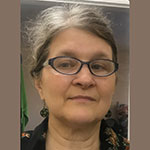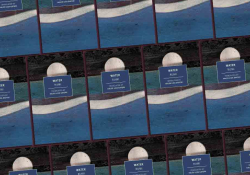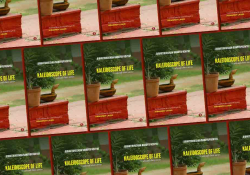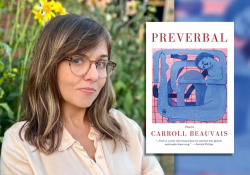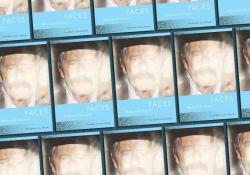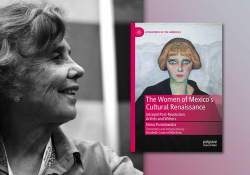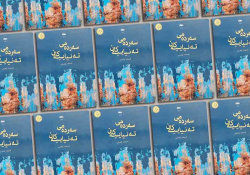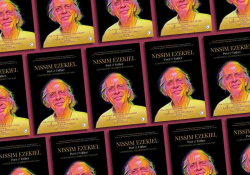A Leningrad Underworld: Polina Barskova’s Living Pictures
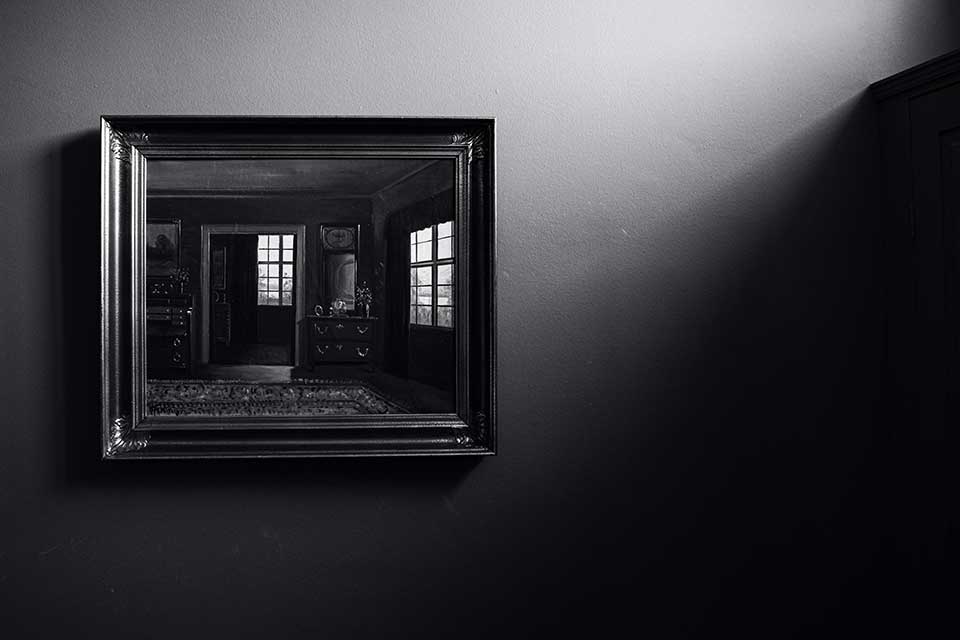
What is the role of the past in our psychic universe? What happens to us if we learn only later about terrible things that took place in our streets, our parks, our own families, revealing dark tunnels beneath everything we thought we understood? Questions like these may strike anyone who grew up in the former Soviet Union, with its repressions and labor camps, but they are especially urgent for a poet and scholar born in in Leningrad like Polina Barskova, author of a new collection published by New York Review Books. Living Pictures (2022), translated by Catherine Ciepiela, refers to a game where participants dress up and assume the poses of famous paintings, quite different from charades—a game more familiar to anglophone readers.
 Born in 1976, Barskova debuted as a poetic prodigy, her first book published when she was nine. She left the Russian Federation at twenty for graduate school, then became a college professor in the United States with a research program focused on writing from the Siege of Leningrad (1941–44). Leningrad has sunk into history, with the city once again called by its original name, St. Petersburg (Sankt Peterburg). With so many personal ties to the place, Barskova is particularly qualified to study the topic and particularly haunted by it. As she points out, stories from the siege (or “blockade,” blokada in Russian) were pressed into archives, hidden from younger generations, leading eventually to a new moment of unhappy discovery. It is odd to think that in Barskova’s childhood a young person in the USSR might have known less about the blockade than an anglophone reader with access to works like Harrison Salisbury’s 1969 book, The 900 Days.
Born in 1976, Barskova debuted as a poetic prodigy, her first book published when she was nine. She left the Russian Federation at twenty for graduate school, then became a college professor in the United States with a research program focused on writing from the Siege of Leningrad (1941–44). Leningrad has sunk into history, with the city once again called by its original name, St. Petersburg (Sankt Peterburg). With so many personal ties to the place, Barskova is particularly qualified to study the topic and particularly haunted by it. As she points out, stories from the siege (or “blockade,” blokada in Russian) were pressed into archives, hidden from younger generations, leading eventually to a new moment of unhappy discovery. It is odd to think that in Barskova’s childhood a young person in the USSR might have known less about the blockade than an anglophone reader with access to works like Harrison Salisbury’s 1969 book, The 900 Days.
Barskova found more than she could have expected, given the suppression of horrific details in everyday Soviet discourse about the Great Patriotic War—it has a different name and different dates (1941–45) from World War II, as it is known in much of the rest of the world. The poet’s discoveries in the archives, presented in scholarly articles and a collection of translations of blockade poetry that she edited (Written in the Dark, 2016), initially sprang up in her poetry, and now we can read them in these striking free-form prose essays. The scholar must keep some cool distance from the facts, while the creative writer’s discoveries cross the membrane into this parabiographical creative nonfiction.
Of course, we’re all walking over ghosts: that’s how the world is made. The blockade, though, breaks through our usual ability to ignore the facts with the sheer monstrosity and otherness of life in the besieged city. Barskova takes her group of study-abroad students to see where Akhmatova lived during the siege (in the weeks before she was evacuated), showing them gaps around the courtyard of Akhmatova’s building through which one could reach the underground: it sounds like the door to Hades in classical myth and epic. She discusses Olga Berggol’ts, a younger poet who stayed in Leningrad and inspired listeners with her passionate readings over the radio, though it was not a great time to be in Leningrad with a German last name. Berggol’ts rhymed “Leningrad” with snaryad (artillery shell) and developed a double identity: cheery and determined outwardly, frank and daring inwardly; she survived (which was unlikely, as Barskova points out) to become one of the first swallows of the so-called Khrushchev Thaw from the mid-1950s to the mid-1960s. A poet is always a model for other poets, or else a reproach, especially if she wrote in the same city.
Vitaly Bianki, whose forebears had changed their surname from Weiss, visited Leningrad during the blockade and left again to write about it powerfully, though it is his personality that Barskova stresses. After her own boyfriend is killed by a car, she is sent to visit family far from the big city in hopes that she will not despair. Every personage who enters the story brings an aura of sex—sometimes a history of inexplicable sexual adventure. Barskova ponders the idiosyncrasies of their (and her) lives, always viewing them with her own vulnerability engaged. Her arguments or presentations of history or biography tend to follow poetic logic (“pregnant with the blockade” = sick and swollen with dystrophy, the physical distortions that accompany starvation), and her own biography and recollections rest atop the city’s tragedy.
Barskova’s arguments or presentations of history or biography tend to follow poetic logic, and her own biography and recollections rest atop the city’s tragedy.
Anna Akhmatova’s late Leningrad poem “The Summer Garden” cites the thousands of steps and traces left by friends and enemies in that garden, a beautiful microcosm of the city that she knows will outlast her. Barskova focuses instead on knowledge denied and suffering repressed. The blockade writers are important (for all their flaws, which she does not ignore) because they tell her, from beyond death, what actually happened. She lists some risks they took: burying notebooks underground not only so they wouldn’t be destroyed by Nazi bombs, but also so they wouldn’t be found and confiscated by the Soviet side. For the wrong people to find them could be worse than losing them forever, along with the truth they were meant to convey. The book’s final section is a short play set in the Hermitage Museum, its characters starving curators whose pictures have been evacuated to safety as they are left to waste away despite their knowledge, passion, and talent. Here the “living pictures” of the book’s title are no longer canvases, and barely even bodies, but they still linger in heartrending words.
The essays here suggest ways to work through personal experience, including assimilating the horrible records of the siege and the bared flaws of someone else’s life revealed in an archive. People ask Barskova, she says, why she chose the blockade, which binds her to the past and now to Russia as well. There is the primary trauma of learning that bodies dead of cold and starvation were buried under the park where she and her friends played as carefree children—populating the underworld of Leningrad, as it were—and the secondary trauma of learning that something like this did happen, that we live in a world where it could happen. It will be new to its new readers too: many if not most of the sections treat poets or other cultural figures of wartime Leningrad, or their afterlives, whom most readers in English will never recognize without the notes appended at the end of the volume. Some readers might enjoy taking the narrative as a fantastic leap with no idea of the person to which it refers—perhaps underlining the author’s point that the blockade created a world that would otherwise seem impossible and is barely more readable for a specialist in Russian history, literature, and culture.
To say “the prose of a poet” is a cliché, but it really is. The poet’s prose departs from ordinary style and makes demands of the translator; rather than choose one word at heightened moments, she may offer a series without intervening commas, or hyphenate two words bound by sound and rhythm as much as meaning. Catherine Ciepiela, a professor and translator of this volume, is not just a colleague of Barskova, deeply informed about Russian poetry, but also a friend, privy to biographical details and able to ask what is most important to convey in the translation. Sound, rhythm, and expressive word order are among the most difficult aspects, and this prose-of-a-poet does make many of the same demands as poetry. Ciepiela’s translation is elegant and powerful, and when there is something playful or strange in the text, you know it is meant to be there: “abuse-amusement,” or “blah-blah-blockade,” which works as well in English as in the original. At more length: “. . . this was the place where they unloaded and burned the weightless transparent glassy tender rigid bodies of the starving, the dystrophics: thousands and thousands and thousands of bodies.”
Bodies are dehumanized, turned into things by this terrible kind of death—all then erased after the war’s end, repressed by Moscow, and stored away underground.
These bodies are dehumanized, turned into things (transparent and glassy) by this terrible kind of death—all then erased after the war’s end, repressed by Moscow, and stored away underground. Wartime suffering had to be collectivized; the same was done, afterward, with the Nazis’ special targeting of the Jews and with the much higher death rates in the Belarusian and Ukrainian SSRs, who lay in the path of the invasion. Their numbers were folded into the overall Soviet numbers, effectively Russified, just as the special, implausible suffering of Leningrad blended into an imperial narrative guided by Moscow. (All that is not to mention the people who were uprooted and sent into exile because they had supposedly supported the enemy or threatened to seek alliance across the borders of the Soviet state. Barskova’s focus does not take her there.)
The collection’s third important element is the introduction by poet Eugene Ostashevsky, who also knows Barskova and her writing well. Ostashevsky has a very strong literary personality, an unmistakable poetic voice, but here he steps back a bit to foreground Barskova’s work and position. The whole book is warmed and balanced by the friendship among the participants and their shared recognition of the importance of the topic: the tragic details of Leningrad and some of its inhabitants, and the trace that these things leave on their heirs, whether or not they are conscious of it.
This fine book has emerged at a difficult moment, though the project obviously began before Russia invaded Ukraine in February 2024. Barskova has continued to write in her native language despite residing in the United States for well over twenty years, and this too is now fraught with questions. For the anglophone reader, this book offers special access to a painful corner of history, but even more it offers deeply felt, constantly perceptive attention to the life and lives it describes.
Swarthmore College
Editorial note: Barskova is one of a dozen translators who contributed to “The Russophone Literature of Resistance” cover feature in WLT’s March 2023 issue.
